Micromoments
Insert these quick activities into your existing class
Put an EM Micromoment In Your Next Class
Get a quick activity to insert into your existing class! Micromoments range from 2 to 30 minutes and are designed to help you develop your students' entrepreneurial mindset (EM). These activities are adaptable to any course.
Jump to activities for:
Curiosity | Connections | Creating Value
Micromoments are courtesy of Megan Morin (North Carolina State University) and Richard Goldberg (University of North Carolina at Chapel Hill). Learn more in Citations.
Curiosity
Curiosity - 2 minute activities
Question Frenzy
Duration: 2 mins
3Cs: Curiosity
Activity
Using an engaging warm-up can spark curiosity from the moment students walk in the door. Students are asked to participate in a multi-step process to create a question that could be used for a project, report, or practice the technique. In this warm-up activity, present a topic, image, or statement and ask students to list as many questions as possible surrounding the stimuli within 2 minutes. Encourage the crazy!
Tip
To expand further, use the Question Formulation Technique in full, as demonstrated in the Resources.
Examples
What questions do you have about this topic, micromoment activities? List them in the Google Doc posted in the chat. Presented in a virtual format.
Resources
Return to top of Curiosity
Return to top of page
I Wonder
Duration: 2 mins
3Cs: Curiosity
Activity
- Identify a trend, of any type, that generates curiosity.
- Identifying an additional challenge is to identify a potential implication — one that matters to the students that could include implications on teaching, technology, research, education, university, just life in general. Write a short two or three-sentence explanation to present to students.
- Ask students to take 2 minutes to write what this makes them wonder about.
Tip
The activity can be expanded to introduce a research topic or be used as a class opener.
Examples
The confluence of social acceptance and access to technology has created a phenomenon in individual trends, according to The Pace of Technology Adoption is Speeding Up in HBR.org.
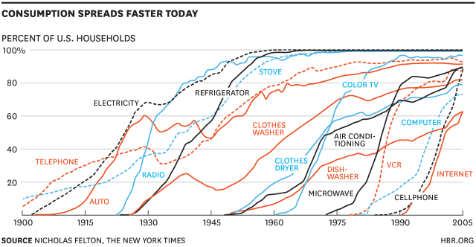
This makes me wonder about:
- What about the last fifteen years? The graph only shows up to 2005. What's on the rise now?
- How does this curve compare to other nations?
- You can clearly see the effect of WWII. I wonder what some of the other perturbations are?
- This is just U.S., but I'd like to see how the curves would change by region and socioeconomic status.
- The decline of the laundromat....clothes washer is 82% in 2005? But will it level-off there?
- Do some come back down? e.g. autos as we become more metropolitan? radio?
Resources
- Data Tools that stimulate curiosity:
- Strategy incorporated in Integrated Curriculum with Entrepreneurial Mindset 1.0 (ICE 1.0).
Return to top of Curiosity
Return to top of page
Just Google It
Duration: 2 mins
3Cs: Curiosity
Activity
Present a problem or challenge both small and large. Ask students to take 2 minutes to investigate, research the problem, learn how the system works, relevant cases, and prior solutions. Anything they can find about the topic.
Tip
Students may find incorrect information. Even better! This is a perfect way to clarify misunderstandings and the significance of reviewing your sources.
You can also make it a competition - who is the first person to find five accurate facts or support.
Examples
Recently, a bridge collapsed in Pittsburgh, PA. How concerned should we be for our infrastructure in the United States? Is it one region or everywhere? Take two minutes to search or google.
Resources
Return to top of Curiosity
Return to top of page
Curiosity - 10 minute activities
Gallery Walk
Duration: 10 mins
3Cs: Curiosity
Activity
Present a gallery of statements or images by itself or on a large easel post-it pad. Students will be provided 10 minutes to write a question for each “station.”
Close the activity by asking the group for takeaways.
Tip
The questions can be written or posted around the room and students can place 3 x 3 post-it notes below or write questions/paste images on a large easel post-it pad.
Examples
Present a gallery of five images and facts of water contamination. Students are to go to each image or statement posted on poster paper and write a question related to the image or fact.
Resources
- CURIOSITY: What do we mean?
- Strategy incorporated in Integrated Curriculum with Entrepreneurial Mindset 1.0 (ICE 1.0).
Return to top of Curiosity
Return to top of page
Curiosity - 15 minute activities
Google Trends
Duration: 15 mins
3Cs: Curiosity
Activity
Google Trends is an online data exploration tool that features real-time search data from Google. Users can explore people’s search interests and find additional data related to current events and interests over time. You can also see popular search terms in a particular region.
Select a topic related to the course (ex. engineering) and search it on Google Trends. Ask students to select a “related query” (it appears after you search).
- How and why has the trend changed over the last ten years?
- Why do these five regions have an interest in the search term?
- Why do people care about this search term?
- Predict the trend in one year, five years, ten years.
Tip
- To take less time, provide more structure with a specific search term and ask one question for discussion.
- The activity can also be used as an introduction to a project to identify relevant topics.
- Students can also read a current event article and be asked to explore Google Trends to further understand how other people perceive the topic and understand value (ex. Emergency Remote Instruction is not Quality Online Learning - ask students to search remote online learning).
Examples
Discuss with students the purpose and function of Google Trends. In pairs, ask students to search engineering and review the related queries or topics. Select on related query or topic. Respond to the following questions on poster paper or a collaborative tool.
- How and why has the trend changed over the last ten years?
- Why do these five regions have an interest in the search term?
- Why do people care about this search term?
- Predict the trend in one year, five years, ten years.
Resources
Return to top of Curiosity
Return to top of page
Curiosity - 30 minute activities
On the Contrary
Duration: 30 mins
3Cs: Curiosity
Activity
Present a statement that will spark curiosity and lend itself to having multiple perspectives. Split groups into teams of 2-3 students and assign them two perspectives, such as proving the statement is true or false or they are justifying or disproving the statement.
Ask students to research their perspectives. In a structured manner, students debate the topic.
Tip
- This activity can be facilitated in a variety of ways with more or less structure.
- One approach: Students can be provided the resources to draw their own conclusions.
- This implementation can be a multiclass activity depending on the weight of the topic.
Examples
Students will debate the question of whether a radiology department should purchase and implement a CAD software tool for mammography that could improve patient outcomes. However, it also could have unintended consequences that would cause harm.
- Students will be assigned in teams of 2-3 for and against. Students will research their stance and conclude with at least three facts to support their stance and three facts that will rebuttal the other stance.
- On a collaborative tool, the students will post each fact onto a collaborative tool.
- The teams for the statement will each share one fact to support.
- The teams against the statement will share one fact to support.
- The instructor will facilitate the rebuttal facts.
Resources
Return to top of Curiosity
Return to top of page
Connections
Connections - 2 minute activities
Painstorming
Duration: 2 mins
3Cs: Connections
Activity
Present to students a concept, process, or product that lends itself to many “pains”. Ask students to take two minutes to list as many “pains” they have observed in this topic, concept, or product.
Tip
Another option is to start with a product that has evolved and ask what pains led to this product. For example, "What pains led to Google Maps?”
Examples
Use Youtube to search: "How to Use Mr. Coffee® 12-Cup Stainless Programmable Coffeemaker." Play the 52-second video to the class. Ask students to list what are the pains in using this product.
Resources
Return to top of Connections
Return to top of page
Connections - 15 minute activities
Bingo!
Duration: 15 mins
3Cs: Connections
Activity
Facilitators/Faculty will list one fact, statistic, or big idea related to a larger topic in a Bingo or square grid. Students will list a concept or example for each big idea. When students identify, an entire row horizontally or vertically earns students a Bingo.
Tip
Difficulty or the size of the grid will determine the time necessary to complete the activity.
Examples
Biology Connections Bingo Board:
List one concept or example from which the big idea may apply. Three in a row horizontally or vertically earns Bingo!
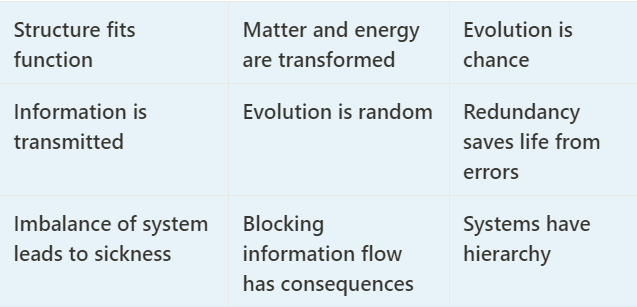
Resources
- See the New York Times - The Learning Network article: "Making It Relevant: Helping Students Connect Their Studies to the World Today"
Return to top of Connections
Return to top of page
Brainstorm, Integrate, Grouping Activity (BIGA)
Duration: 15 mins
3Cs: Connections
Activity
Present a problem to your class.
- Brainstorm. Independently, ask students to brainstorm solutions for five minutes.
- Integrate. Small groups of three to four students will place their post-its on a wall or virtual wall.
- Grouping Activity. If students don’t naturally do it already, ask students to gather similar words/ideas. Ask how the groupings relate to one another. Identify a term for the system or group that brings the interconnectedness/commonality.
Tip
- The goal is to help students to see a system within their problem. Be sure to select topics for this activity that lend to the goal.
- If in-person, make sure to have enough materials and wall space. See the workshop card below for further tips.
Examples
You are designing a self-driving car. What sensors do you need?
Resources
Return to top of Connections
Return to top of page
Be Considerate
Duration: 15 mins
3Cs: Connections
Activity
Present a design challenge. Individually, ask students to create a bulleted or number list of relevant things that must be considered in the design. What questions need to be answered? What do you need to ensure a good design?
Tip
This is a great strategy to kick off a project. Targeting a real problem or scenario will help to attribute to the development of EM.
Examples
Aunt Ada reveals she wants to construct what can only be described as an epic treehouse. You take the job so your first phase of work is to determine relevant parameters dictating the design of the trunk. This first phase is to be done as an individual exercise; you should create a bulleted or numbered list of relevant things that must be considered in designing the trunk. In other words, what questions need to be answered and, with those answers, what do you need to do to ensure a good design.
Student Response Example:
- How high off the ground should the treehouse sit?
- Size of the trunk - are there diameter restrictions? Making people feel safe vs. making it monolithically large
- Weight of the treehouse
Resources
Return to top of Connections
Return to top of page
Highlight the Best Features
Duration: 15 mins
3Cs: Connections
Activity
Present a technology. Using a table:
- Ask students to identify 3-5 features of the technology and list them as headings in the table.
- Within each column, ask students to list 3-5 examples of that feature (ex. type of battery, type of motor).
- Ask students to select an attribute from each column to create a product. Highlight final selections.
Tip
This is an abbreviated version of the Matrix Approach (see card #2448 below) and Morphological Thinking. The matrix ideation approach shown in the video is fully morphological thinking when the matrix contains a representative set of attributes of one solution.
Once students are more comfortable with the approach, students can be provided more freedom for an open ideation session to consider all features and attributes, and possibilities.
Examples
Students were asked to complete the features table for a flashlight, and an example is shown below.
- Identify three features or attributes of a flashlight and insert the responses at the top of the table.
- Fill in the columns and list the possibilities of these attributes.
- Select one example of each attribute for a flashlight product. Who would be the user? How would they use the product?

Resources
- Creating Value Means Going Beyond Problem Solving (Card #2263)
- Creating Value Direct Assessment: A Matrix Approach to Defining Value (Card #2448)
Return to top of Connections
Return to top of page
Connections - 20 minute activities
The Analogy Triad
Duration: 20 mins
3Cs: Connections
Activity
Students will use The Analogy Triad to identify analogies of a course topic to real-life experience, course topic to a random topic, and the random topic and real-life experience.
In the assignment, students can select a topic in the course or be provided a given topic or focus area to complete the topic to identify analogies connected to each idea.
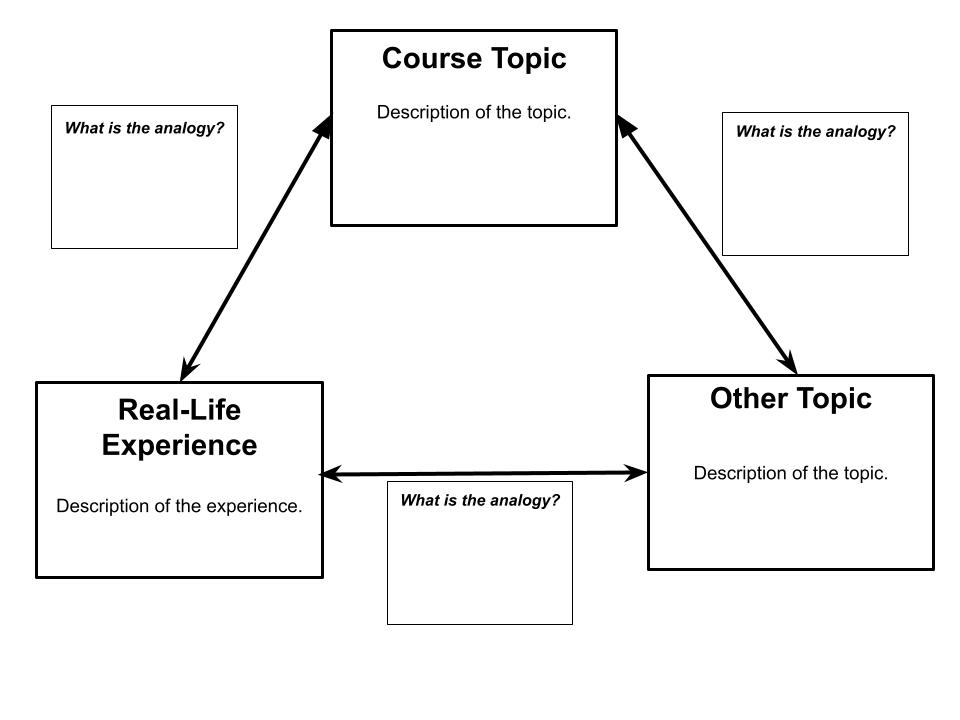
The template can be found here.
Tip
Discuss with students examples of analogies before the activity. Students may need the activity modeled or examples provided before they complete the triad. This can also be conducted as a reflection paper as demonstrated in Card #921.
Examples
Topic: Circuit Diagrams
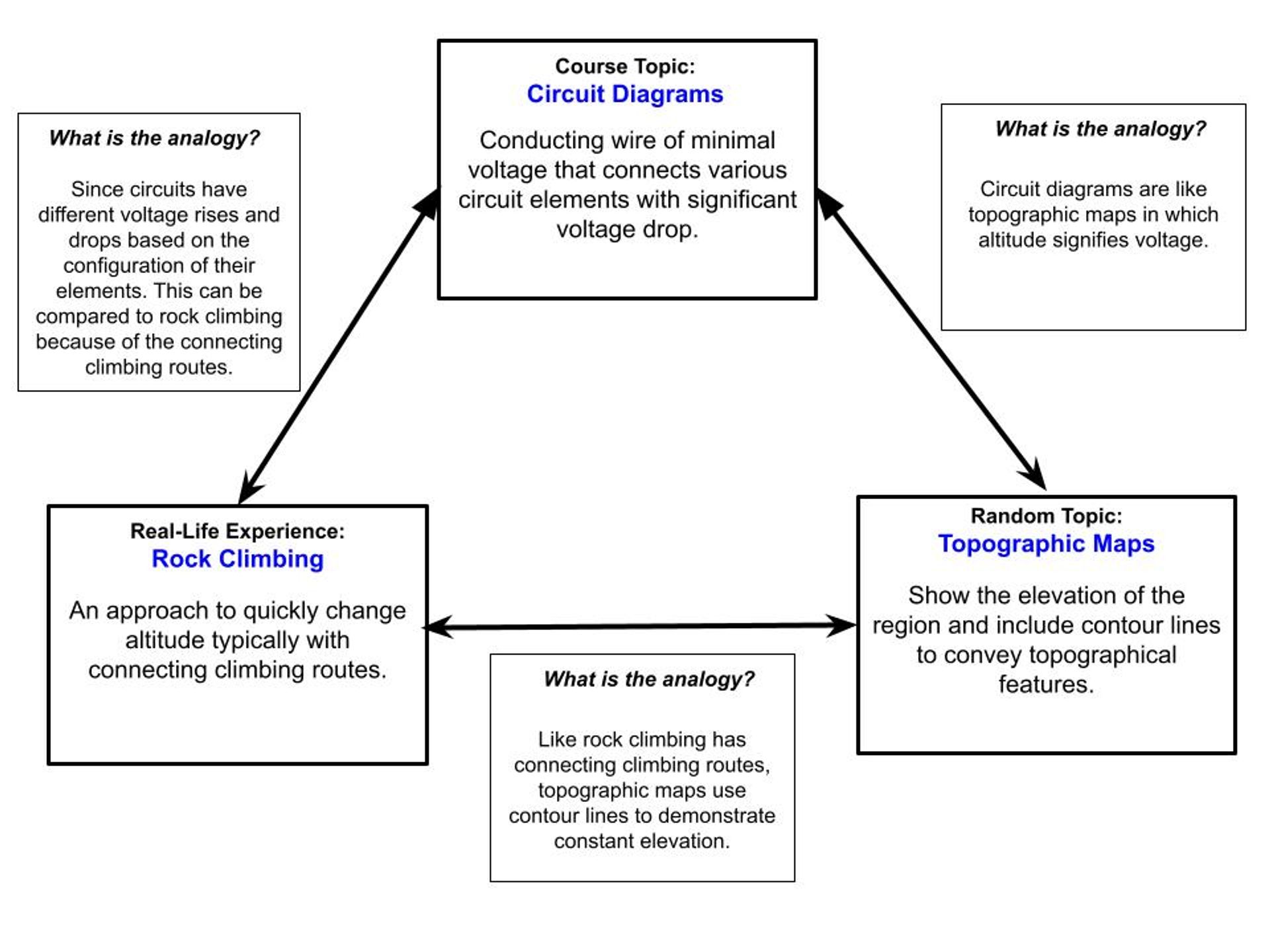
Resources
- ASEE Paper: How Analogies Fit in a Framework for Supporting the Entrepreneurial Mind-set in an Electric Circuits Course
- How Analogies Fit in a Framework for Supporting the Entrepreneurial Mindset in an Electric Circuits Course (Card #921)
Return to top of Connections
Return to top of page
Connect the Dots
Duration: 20 mins
3Cs: Connections
Activity
Students are to create a concept map containing concepts from and that relate to the course using pen/paper or software of choice (if comfortable). To create the map:
- Use the name of the topic as the central topic and ask students to list three concepts branch related to the central topic.
- Ask students to list 2-3 details for each branch with the branch.
- Ask students to add five more branches to the existing branches.
Tip
The activity will need to be modified based on the student's experience, such as:
- Modeling the process
- Creating a concept map with different components blank
- For less structure, ask students to generate the topic to create the map.
There is software to create a concept map, such as Cmap.
Examples
Create a concept map for the engineering design process. This example is from Concept Mapping, a Tool for Assessment of First Year Students' Understanding of the Design Process:
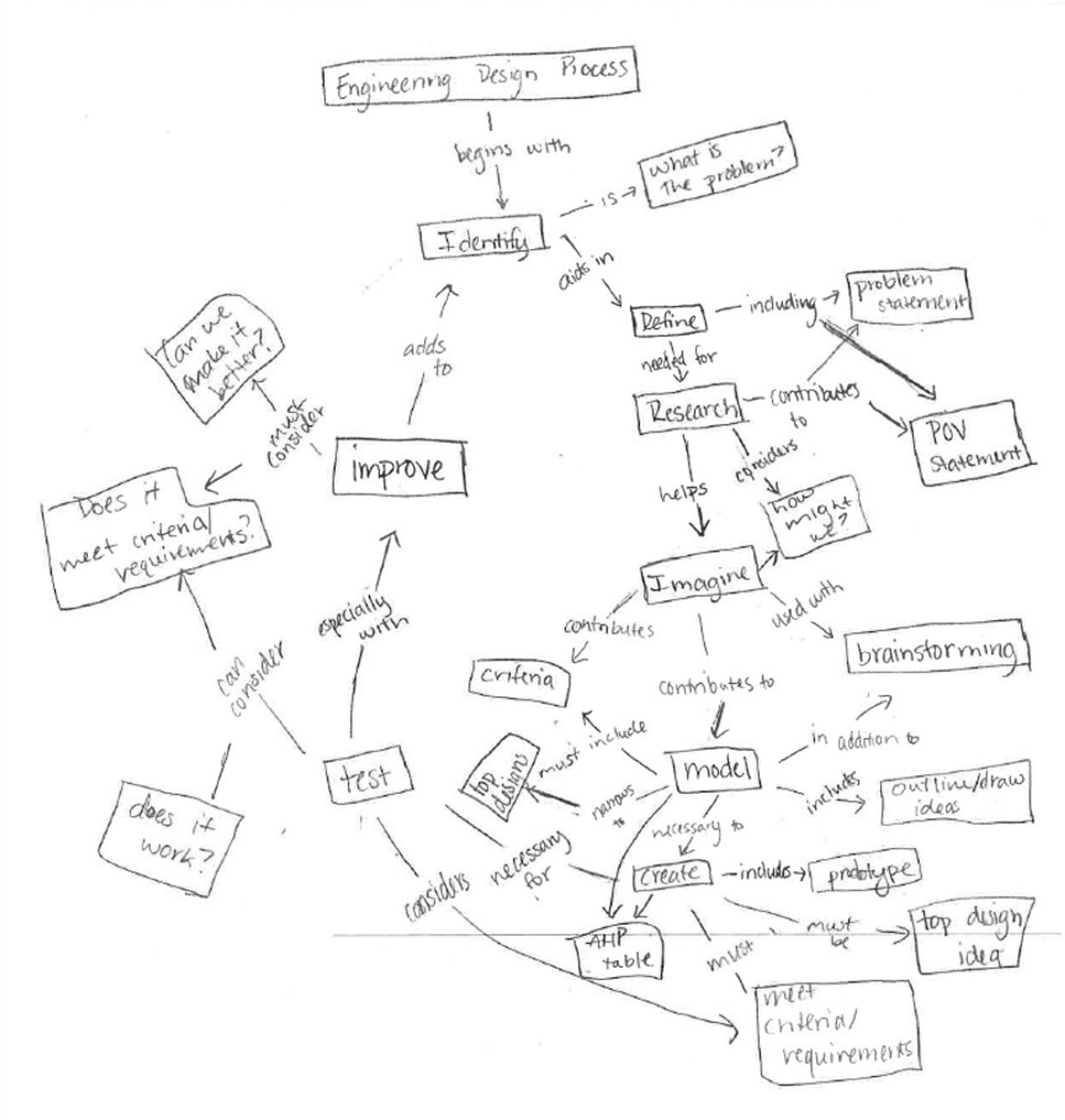
Resources
- Concept Mapping, a Tool for Assessment of First Year Students' Understanding of the Design Process
- From Assessment to Research: Exploring 3C Direct Assessments and Future Research Projects (2022 KNC Session)
Return to top of Connections
Return to top of page
Make It Relevant
Duration: 20 mins
3Cs: Connections
Activity
Select an article or photo. Ask students to identify examples using the following prompts:
Focusing on example-to-self connections:
Does anything in this example remind you of anything in your own life?
Focusing on example-to-concept connections:
What does this example remind you of another concept you have learned? How is this example similar to other concepts you have learned? How is this example different from other concepts you have learned?
Focusing on example-to-society connections:
How might this example relate to societal issues?
Tip
These questions can be used also for generating ideas for a larger research project.
Examples
The instructor shows a picture of coral reef bleaching and discusses the changes at the organismal and wider ecological levels.
Example Student Response:
Focusing on example-to-self: I went scuba diving when I was in college at the great barrier reef and I’m sad to hear so much as bleached. I recently went snorkeling in the Bahamas with kids, they were amazed, I was saddened because I saw noticed so much bleaching.
Focusing on example-to-concept connections: Seeing one type of organism die out that leads to fewer fish and biodiversity, reminds me of an example with monoculture farming, pollinating honeybees the effect on biodiversity and farming.
Focusing on example-to-society connections: Bleaching is a result of climate change—human-caused. Ultimately it affects the biodiversity of life and this comes back to be another human issue- food to support a growing population. How do we make policies that slow and reverse global warming? How do we make coral bleaching, polar bears starving and other biological systems falling apart matter to humans?
Resources
- See the New York Times - The Learning Network article: "Making It Relevant: Helping Students Connect Their Studies to the World Today"
Return to top of Connections
Return to top of page
Connections - 30 minute activities
Biomimicry
Duration: 30 mins
3Cs: Connections
Activity
Part 1. Introduce the Natural Process (10 min)
Instructors choose a natural phenomenon of their preference. Have students spend time individually researching and discussing in teams what echolocation is, how it works, and which animals use it and why.
Part 2. Consider Applications (10+ min)
Now have students work in teams to brainstorm and list all of the possible human-driven applications of this technology. Students should list ones that they already know, ones that they find through research, and ones that don’t necessarily exist but are imaginable/desirable.
Part 3. Share Out (5 min)
Have each team share some of the things that they had listed, encouraging them to share the most interesting or lesser-known applications they had come up with. Wrap-up by sharing (through paper copies) or verbally summarizing some latest research developments in this area.
Tip
Depending on the students' understanding of biomimicry, they could be presented with the concept or topic and be asked to develop their own idea of biomimicry.
Examples
Instructors choose a natural phenomenon of their preference. One possible example is “echolocation”, but the website asknature.org is a great source of other ideas. Have students spend time individually researching and discussing in teams what echolocation is, how it works, and which animals use it and why.
Have each team share some of the things that they had listed, encouraging them to share the most interesting or lesser known applications they had come up with. Wrap-up by sharing (through paper copies) or verbally summarizing some latest research developments in this area, such as Bat-Inspired Tech Could Help Blind People See with Sound.
Resources
Return to top of Connections
Return to top of page
What’s That Have To Do With It?
Duration: 30 mins
3Cs: Connections
Activity
This activity will help students brainstorm solutions to a challenge by using an unrelated image as a source of inspiration. To prepare for this activity, consider a problem or challenge to present to the class. Identify an image that is not directly related, but could inspire ideas to address this problem. You will do this in the opposite order by presenting the image first, and then the challenge.
During class, with groups of 3-4 students:
- Show the image to the class. Independently, ask students to list everything they know about the image for five minutes. Each idea should be put on an individual post-it note.
- Within each group, students compile their answers/post-its and organize their responses into common themes.
- Present a problem or challenge to the class.
- Ask students how the image can be a source of inspiration to address the problem.
- Students share their responses verbally or using a collaborative tool.
Tip
Walk through the ideation process yourself. Will students see the connection?
Examples
The challenge is to develop a medical care device that is not scary for a young patient. They will use a McDonald’s Happy Meal as a source of inspiration. Follow the above procedure by first sharing a photo of a Happy Meal, asking students to list everything they know about it. Then present the challenge of developing a medical device (anything from a needle to an MRI machine) then ask how the Happy Meal can inspire ideas to make this device less threatening to children.
Resources
Return to top of Connections
Return to top of page
Creating Value
- 5 minute activities
- 10 minute activities
- 15 minute activities
- 20 minute activities
- 30 minute activities
Creating Value - 5 minute activities
How Do We Make This Better?
Duration: 5 mins
3Cs: Creating Value
Activity
Present to students a design, concept, or process. Simply ask, “How do we make this better?”
Students list as many things as they can on a collaborative tool or on a piece of paper. Facilitate a brief discussion with students or what is reported on a collaborative tool.
Tip
This could be done as a gallery walk of different designs or processes.
Be careful using this approach on student work. Without coaching, the feedback could be more detrimental than good for the students.
Examples
How could we design better COVID-19 testing procedures?
Resources
- Process Improvement of an Assembly Operation
- Customer Pain Point Discovery and Online Product Redesign Project
- Prince, M. (2004). Does active learning work? A review of the research. Journal of Engineering Education (Washington, D.C.), 93(3), 223-231. https://doi.org/10.1002/j.2168-9830.2004.tb00809
Thank you to Margot Vigeant from Bucknell University for her contribution.
Return to top of Creating Value
Return to top of page
Creating Value - 10 minute activities
What is Value?
Duration: 10 mins
3Cs: Creating Value
Activity
Very often students struggle with the idea of value. Before incorporating value based activities, discuss with students the concept of value.
Ask students:
- What "value" have you gained today? What was the most valuable thing you gained in the past week?
- Present your definition of value. Example responses: Value is the perfection of the customer Value is the benefits divided by the costs.
- Provide a brief case study/scenario (3-4 sentences) that connects to the student experience.
Ask students to consider the example. How do they value the product or design?
Tip
The activity is made to supplement other and future activities that incorporate the concept of creating value.
Examples
Case Scenario:
In the 1960’s Mercedes added cup holders to their cars. It was a few cents worth of plastic that allowed them to sell their cars for almost $1000 more!
Question: Think of your favorite car feature. In what way(s) does it add value? When was it added as a feature?
Resources
Return to top of Creating Value
Return to top of page
The Reviews Are In
Duration: 10 mins
3Cs: Creating Value
Activity
Teams of 3-4 students work together to discover customer pain points of an online product using Amazon customer reviews with the aim to improve the product.
- What was the value of the product?
- What were the problems with the product?
- What 1-2 recommendations do you have to make the product more valuable?
Students respond to the prompts on an in-person (post-it notes) or virtual (Mural, Jamboard, Miro) collaborative tool.
Tip
- The activity can be used as part of larger project implementation as demonstrated in the card linked below.
- This approach is similar to painstorming, but with a twist.
Examples
Product: WonderMill Automatic Electric Mill
Example of major concerns and pain points of the customer (more examples in card linked below):
- A few customers have experienced difficulties with the grinder motor overheating and damaging the mill.
- Customers generally think that the mill is too loud.
Resources
Return to top of Creating Value
Return to top of page
Creating Value - 15 minute activities
Mind The Gap
Duration: 15 mins
3Cs: Creating Value
Activity
Identify a case that lacked research or knowledge in its preliminary design (ex. Lucky Iron Fish). Present the earlier prototype and ask students to explore the information gap in the case by asking:
- What was the information gap?
- How did that influence the design?
- How did the use of the design change from the first prototype to the second?
Tip
Providing a strong example of the information gap will help students to see the significance of EM, such as the Lucky Iron Fish. No one used their product in Cambodia until they changed it from an iron block to a fish.
Examples
Present the YouTube video clip, Lucky Iron Fish: Shape of Good Health. Ask students to identify other engineered products that would benefit from understanding the users and how they influenced the use of the design.
Resources
Return to top of Creating Value
Return to top of page
What’s At Stake?
Duration: 15 mins
3Cs: Creating Value
Activity
Present a prototype of a product, system, or process to students. Ask students to brainstorm 3-5 stakeholders and 3-5 features of the product, system, or process using the table below.

Ask students to use different colors or thicknesses of lines and fonts to highlight the relative importance of both your stakeholder and what features that particular stakeholder is most interested in.

Tip
These maps can be made more in-depth thinking depending on student experience with these terms and by asking for more stakeholders and features. Instructors could create a Stakeholder Feature Model and ask students to link the arrows to implement in 5 minutes.
Examples
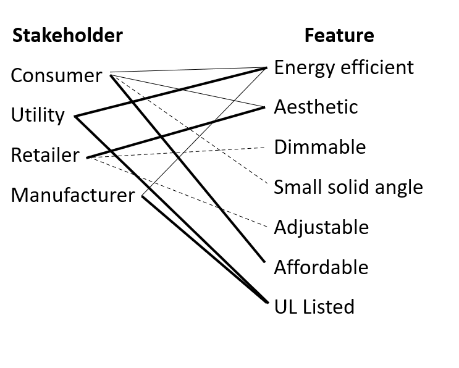
Resources
Return to top of Creating Value
Return to top of page
Creating Value - 20 minute activities
Walk a Mile in Their Shoes (The Empathy Map)
Duration: 20 mins
3Cs: Creating Value
Activity
Provide a short story about a client and the problem/struggle they are facing. Ask students to think of the user and "walk a mile in their shoes." Create an empathy map to understand the user of the product or process by creating a visual to address the following questions.
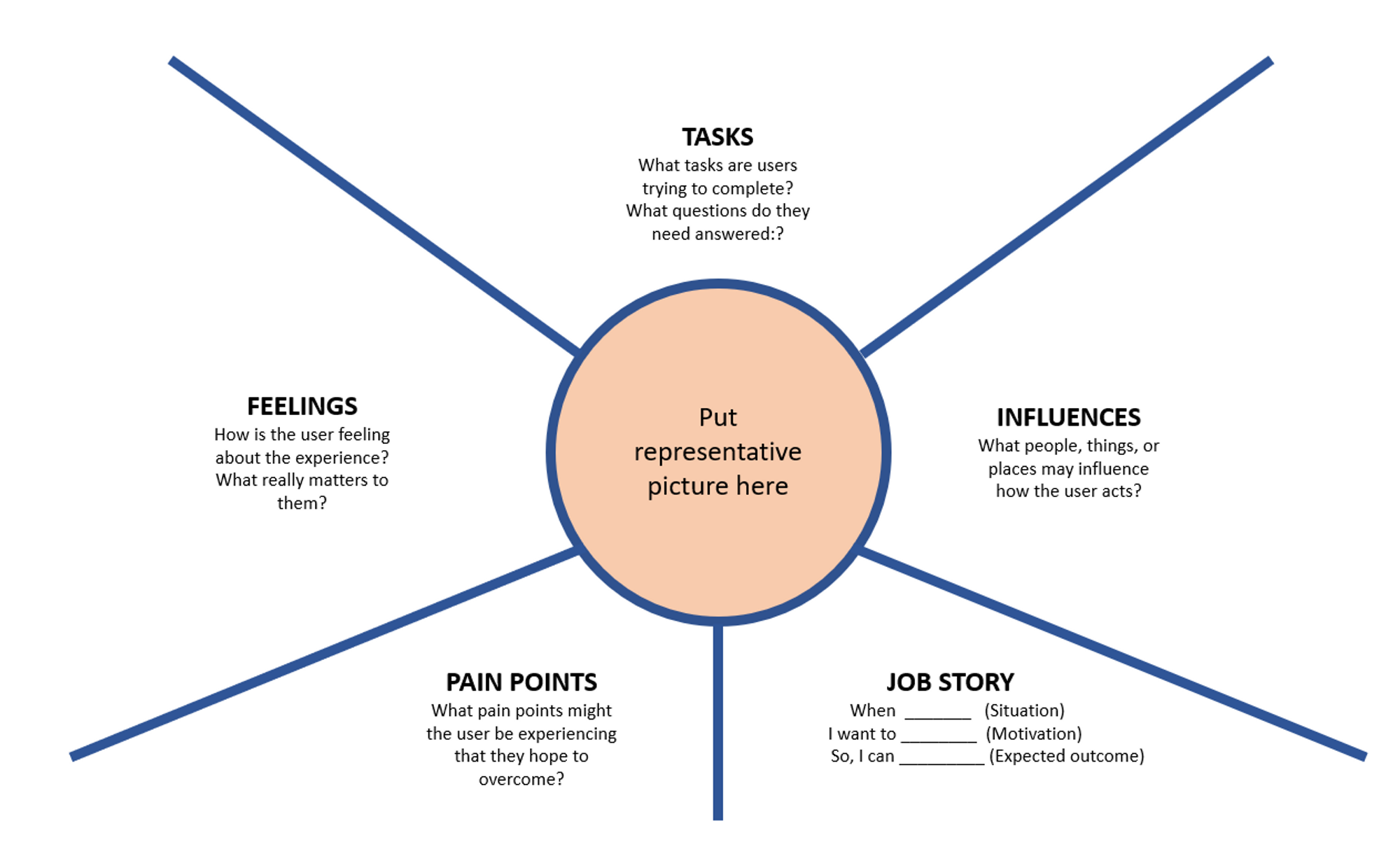
Ask students to use different colors or thicknesses of lines and fonts to highlight the relative importance of both your stakeholder and what features that particular stakeholder is most interested in.
Tip
- See Resources for the graphic organizer.
- The story should address all components.
- The activity works great to supplement a client interview.
Examples
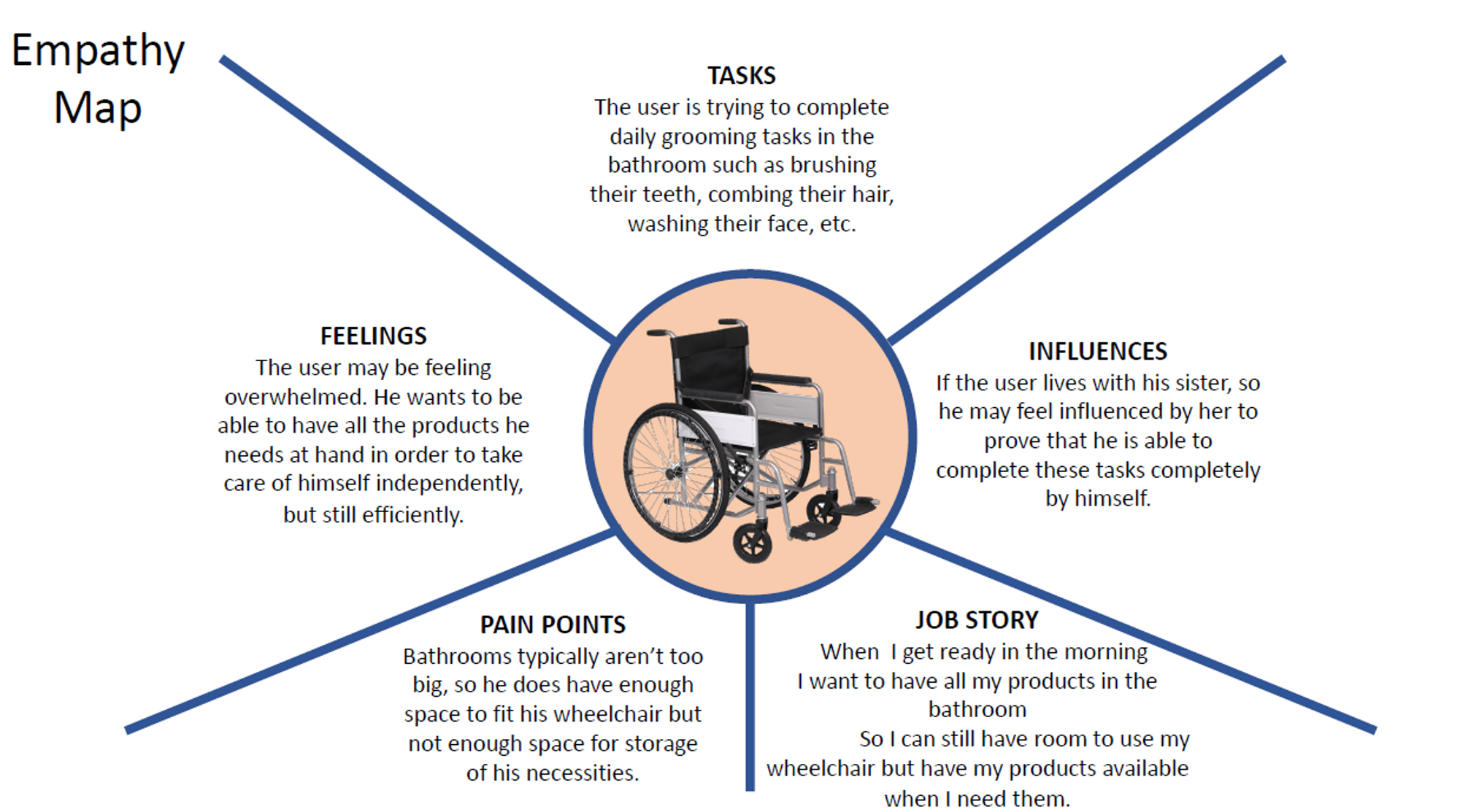
Resources
- End User Feedback - The Empathy Map includes downloadable copies of the above images.
Return to top of Creating Value
Return to top of page
Crack the Case
Duration: 20 mins
3Cs: Creating Value
Activity
Select a case study related to a relevant product or process. Ask students to identify three key stakeholders and three key features related to the product or process surrounding the case study. Discuss with students, “What lessons about value emerge from the study?”
Tip
See the Creating Value card in Resources to find many products that lend themselves to the activity. It is also helpful to have a discussion with students about the definition of value and what it means to them, in engineering, and to users/clients.
Examples
Present "The Pitch for the Keurig Kold".
Stakeholder: Drinker, Buyer, Maintainer
Feature: Drink variety, Durable, Drink Taste
“What lessons about value emerge from the case study?”
Example Response: The product does not provide value. The machine was too expensive, soda consumption is falling, and the machine is too big, loud, and inconvenient.
Resources
- Creating Value Means Going Beyond Problem Solving
- For more case studies, try this search
Return to top of Creating Value
Return to top of page
Paper Prototyping
Duration: 20 mins
3Cs: Creating Value
Activity
Students are to create a paper prototype using tape, scissors, and other low-fidelity materials. This could be used to reinforce a technical concept in your class, or to build teamwork and prototyping skills. See the examples for ideas.
- Introduce the challenge (5 min)
- Design a prototype the challenge (10 min)
- Conclude the activity by sharing prototypes through collaborative tools or a brief discussion. (5 min)
Tip
These can be implemented on a larger scale but will require more time.
Low Fidelity Materials
Examples
- For a thermodynamics unit, students construct a Sterling-cycle engine using a combination of makerspace made components and everyday objects.
- For an aerodynamics unit, students create an airfoil lift measurement device using a makerspace kit of parts.
- For a materials science unit, students create a composite beam that meets design and engineering objectives using low fidelity prototyping materials.
- Prototype something that you would sell in the school bookstore.
- Build a tower at least 2 feet tall that can support a 1-lb weight.
- Create a shadow puppet that can move or transform.
- Make an object that tells a story about your first day of college.
- Prototype a new tabletop game or sport that you can play.
- Create an award for something (or someone) that deserves it.
- Build a thing that can roll down a ramp and travel at least 4 feet.
- Design and make something that is wearable.
Resources
- MakerSpark: A design framework for high value making activities that bring engineering concepts to life (2022 KNC Session)
- EMphasizing Making
Return to top of Creating Value
Return to top of page
Creating Value - 30 minute activities
How Can I Help?
Duration: 30 mins
3Cs: Creating Value
Activity
To understand the concept of user challenges, students will be partnered in pairs. Each partner will interview each other to understand personal challenges that would benefit from a design or technology.
Students will have a five-minute interview starting with these questions:
- What is a challenge that you face often that could benefit from technology?
- How could the technology assist your challenge?
- What are some features of the technology that you think could help with your challenge?
After each student conducts a five-minute interview, independently, the pair will brainstorm for 5-10 minutes an idea for a product to assist their peer with a preliminary prototype. At the end of the brainstorm session, each pair will share for three minutes and ask their peer for one thing that they did like and one thing they would improve.
Tip
The purpose is for students to understand that their ideas need to provide value to others as well as build empathy. The activity can be more extensive with more interviews or different audiences. It can also be focused on a specific challenge (ex. Remote learning). This exercise can be helpful to prepare students to interview professionals.
Examples
Students will understand a specific challenge related to managing their class assignments and deadlines. Each student will ask the following:
- What are some challenges you face in managing your class assignments and deadlines?
- Can you provide a specific example of when you were able to do this well and not well?
- How could technology assist your challenge?
- What are some features of the technology that you think could help with your challenge?
Resources
Return to top of Creating Value
Return to top of page
Citations
Megan Morin (North Carolina State University) and Richard Goldberg (University of North Carolina at Chapel Hill) formed a hypothesis that quick activities - micromoments - will help students develop their entrepreneurial mindset while requiring minimal preparation and class time.
In the process, micromoments will encourage faculty to become more comfortable and confident with implementing entrepreneurial mindset. In turn, this helps to sustain pedagogical change and promote more extensive and frequent implementation.
Most importantly, students will have more opportunities for engaging learning experiences to develop an entrepreneurial mindset.